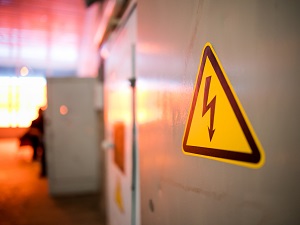The following hazards are the most frequent causes of electrical injuries on construction sites.
- Path to Ground Missing or Discontinuous
- Contact with Power Lines
- Lack of Ground-Fault Protection
- Improper Use of Extension and Flexible Cords
- Equipment Not Used in Manner Prescribed

Path to Ground Missing or Discontinuous
If the power supply to the electrical equipment at the job site is not grounded or the path has been broken, fault current may travel through a worker's body, causing electrical burns or death.
Even when the power system is properly grounded, electrical equipment can instantly change from safe to hazardous because of extreme conditions and rough treatment.
- Ground all power supply systems, electrical circuits, and electrical equipment.
- Frequently inspect electrical systems to ensure that the path to ground is continuous.
- Visually inspect all electrical equipment before use. Take any defective equipment out of service.
- Do not remove ground prongs from cord- and plug-connected equipment or extension cords.
- Use double-insulated tools and equipment that are properly labeled.
- Ground all exposed metal parts of equipment.
Contact with Power Lines
Overhead and buried power lines at the job site are especially hazardous because they carry extremely high voltage. Fatal electrocution is the main risk but burns and falls from elevations are also hazards. Using tools and equipment that can contact power lines increases the risk.
- Conduct a hazard assessment to identify and address potential safety hazards before work begins.
- Look for overhead power lines and buried power line indicators. Post warning signs.
- Contact utilities for buried power line locations.
- Stay at least 10 feet away from overhead power lines.
- Unless you know otherwise, assume overhead lines are energized.
- De-energize and ground lines when working near them. Other protective measures include guarding or insulating the lines.
- Use non-conductive wood or fiberglass ladders when working near power lines.
- Ask the electric company to de-energize and ground overhead power lines.
- Wear PPE, such as rubber insulating gloves and insulating sleeves, and industrial protective helmets.
Lack of Ground-Fault Protection
Due to the dynamic, rugged nature of construction work, normal use of electrical equipment at the job site causes wear and tear that can result in insulation breaks, short-circuits, and exposed wires.
If there is no ground-fault protection, a ground-fault can occur that sends current through a worker's body, resulting in electrical burns, explosions, fire, or death.
- Use ground-fault circuit interrupters (GFCI) on all 120-volt, single-phase, 15- and 20-ampere receptacles, or have an assured equipment grounding conductor program (AEGCP).
- Follow the manufacturer’s testing procedure to ensure any GFCI is working correctly.
- Use double-insulated tools and equipment.
- Use tools and equipment according to the instructions included in their listing, labeling or certification.
- Visually inspect all electrical equipment before use. Remove from service any equipment with frayed cords, missing ground prongs, cracked tool casings, etc. Apply a warning tag to any defective tool and do not use it until the problem has been corrected.
OSHA Standard 1926.404(b)(1)(ii) All 120-volt, single-phase 15- and 20-ampere receptacle outlets on construction sites, which are not a part of the permanent wiring of the building or structure and which are in use by employees, shall have approved ground-fault circuit interrupters for personnel protection.
Improper Use of Extension and Flexible Cords
The normal wear and tear on extension and flexible cords at any job site can loosen or expose wires, creating hazardous conditions. With the wide use of power tools on construction sites, flexible extension cords often are necessary, but because they are exposed, flexible, and unsecured, they are more susceptible to damage than fixed wiring.
Hazards are created when cords, cord connectors, receptacles, and cord- and plug-connected equipment are improperly used or maintained.
- Use factory-assembled cord sets. Use only extension cords that are 3-wire type. Use only extension cords that are marked with a designation code for hard or extra-hard usage.
- Use only cords, connection devices, and fittings that are equipped with strain relief.
- Remove cords from receptacles by pulling on the plugs, not the cords.
- Periodically inspect cords on-site. Any cords found not to be marked for hard or extra-hard use, or which have been modified, must be taken out of service immediately.
- Extension cords should not be tangled or pinched to prevent damage. Wrapping cords around metal structures poses a serious electrocution risk.
OSHA Standard 1926.405(a)(2)(ii)(J) Extension cord sets used with portable electric tools and appliances shall be of three-wire type and shall be designed for hard or extra-hard usage.
Equipment Not Used in Manner Prescribed
If electrical equipment is used in ways for which it is not designed, workers can no longer depend on safety features built in by the manufacturer. This may damage equipment and cause injuries.
- Use only equipment that is approved to meet OSHA standards and use all equipment according to the manufacturer's instructions.
- Do not modify cords or use them incorrectly.
- Be sure equipment that has been shop fabricated or altered is in compliance.
OSHA Standard 1926.403(b)(2) Listed, labeled, or certified equipment shall be installed and used in accordance with instructions included in the listing, labeling, or certification.
Common Examples of Misused Equipment
- using multi-receptacle boxes designed to be mounted by fitting them with
- a power cord and placing them on the floor
- fabricating extension cords with non-metallic sheathed cable (like ROMEX®)
- using equipment outdoors that is labeled for use only in dry, indoor locations
- attaching ungrounded, two-prong adapter plugs to three-prong cords and tools
- using circuit breakers or fuses with the wrong rating for over-current protection (example: using a 30-amp breaker in a system with 15- or 20-amp receptacles)
- using modified cords or tools (like removing ground prongs, face plates, or insulation) or using cords or tools with worn insulation or exposed wires
.jpeg)

.jpeg)